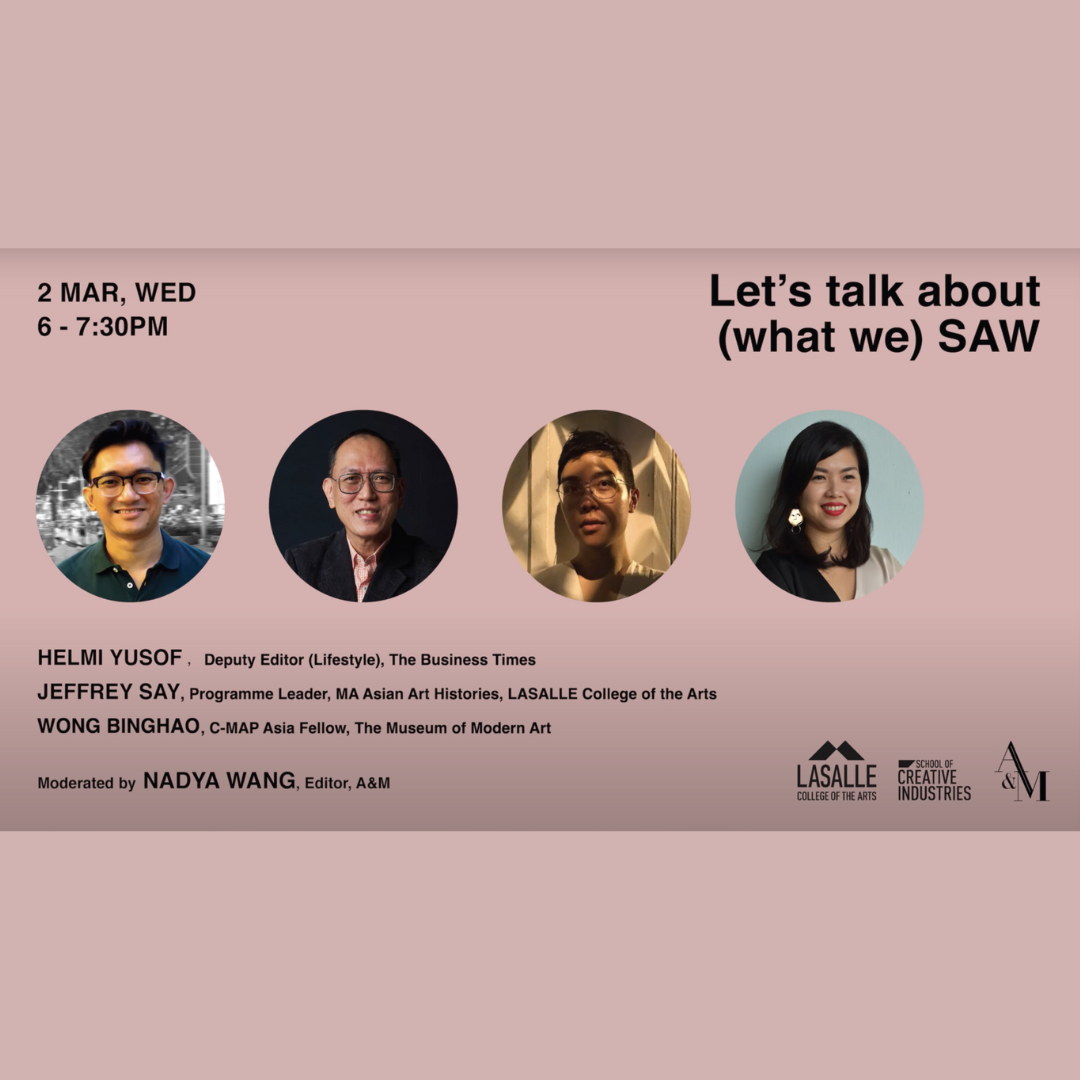Let’s talk about (what we) SAW Part 2
Lightning presentations moderated by Audrey Wong
By Ian Tee
<div class="sharethis-inline-share-buttons"></div>
Screenshot of talk. Clockwise from top left: Teck Lim, Audrey Wong, Nurshafiqa Mohd Noor, Ni Molin, Danson Kok and Kristi Lim, and Natasha Lin.
Key points:
With 130 events happening as part of SAW, it was a challenge to organise one’s time and navigate the wide range of programmes.
Social media is a crucial space for spreading awareness about SAW and attracting visitors.
Despite the convenience and accessibility of digital programming, in-person interaction is still valued.
Lastly, a more comprehensive pre-event marketing and a post-event platform will make SAW a more complete experience.
Organised by the MA Arts and Cultural Leadership programme at LASALLE College of the Arts in partnership with Art & Market, ‘Let’s talk about (what we) SAW’ was a two-part forum that responded to Singapore Art Week (SAW) 2022.
The second event saw a lively discussion about the experience of and creative responses to SAW 2022. The panel featured lightning presentations by Nurshafiqa Mohd Noor, Teck Lim, Stellah Lim, Kristi Lim and Danson Kok, and Ni Molin and Natasha Lin. The talk was moderated by Wong Wai Yen Audrey, Programme Leader, MA Arts and Cultural Leadership, LASALLE College of the Arts.
Here are the takeaways from the session:
With 130 events happening as part of SAW, it was a challenge to organise one’s time and navigate the wide range of programmes. Teck’s video ‘Time and SAW’ captured his wish to have more time to engage with and enjoy the offerings. Natasha and Stellah asked the question if it were possible to attend all 130 events. Taking a systematic approach, they assessed the SAW programme booklet’s efficacy as a guide to planning one’s itinerary. Stellah observed inconsistencies between the event listing and maps provided, noting that their numerical sequence could have been organised into a smooth route to help readers save on travel time. On the digital front, Natasha pointed out issues accessing the booklet on mobile interfaces such as its unresponsive sizing and general lengthiness.
While the SAW booklet contains essential information, the content could be organised with more nuance. The speakers suggested potential trajectories such as start/end dates for better time management and art genres to help audiences identify their area of interest.
Social media is a crucial space for spreading awareness about SAW and attracting visitors. The panellists were heartened by the increase in interest and long queues at certain venues such as Tanjong Pagar Distripark. However, Nurshafiqa and Natasha noted that the attendance was unequal and popular events represented only a small fraction of the entire SAW programme. Danson and Kristi’s film ‘Ate’ reflects on the other bodies in art spaces and the idea of consumption. It considers how our modes of consumption may instead alienate us from the artworks. Therefore, even though social media is a powerful tool for reaching new audiences, it is a double-edged sword.
Despite the convenience and accessibility of digital programming, in-person interaction is still valued. Teck prioritised events that could be replicated online such as Islands Time-Based Art Festival (ITBA) which was dedicated to the live presentation and discussion of ephemeral art forms. Kristi echoed this sentiment, highlighting the value of attending talks physically as it allows one to meet the speakers and network. Nurshafiqa’s presentation on her involvement as a volunteer for Mai Yuyan’s exhibition ‘Blood’ is also a testament to the deep level of engagement made possible with physical interaction.
Lastly, a more comprehensive pre-event marketing and a post-event platform will make SAW a more complete experience. Natasha and Molin wish to see a clearer branding SAW identity which communicates SAW’s mission to the general public. They believe this will not only better inform audiences but also prime them to participate when events happen. Molin cites the ‘Light to Night’ pre-event marketing as a successful case study which not only built anticipation but also gave insights into the hard work that went into organising the event.
Teck and Nurshafiqa welcomed the idea of a post-event platform directly tied to SAW which consolidates responses and creative reviews from practitioners and the public. Kristi agreed, saying that while individuals could upload their video responses on hosting sites such as Youtube, it would not reach the same audience as a dedicated post-event platform.
Watch the full recording of ‘Let’s talk about (what we) SAW Part 2’ here:
Read our summary for ‘Let’s talk about (what we) SAW Part 1’ here.














